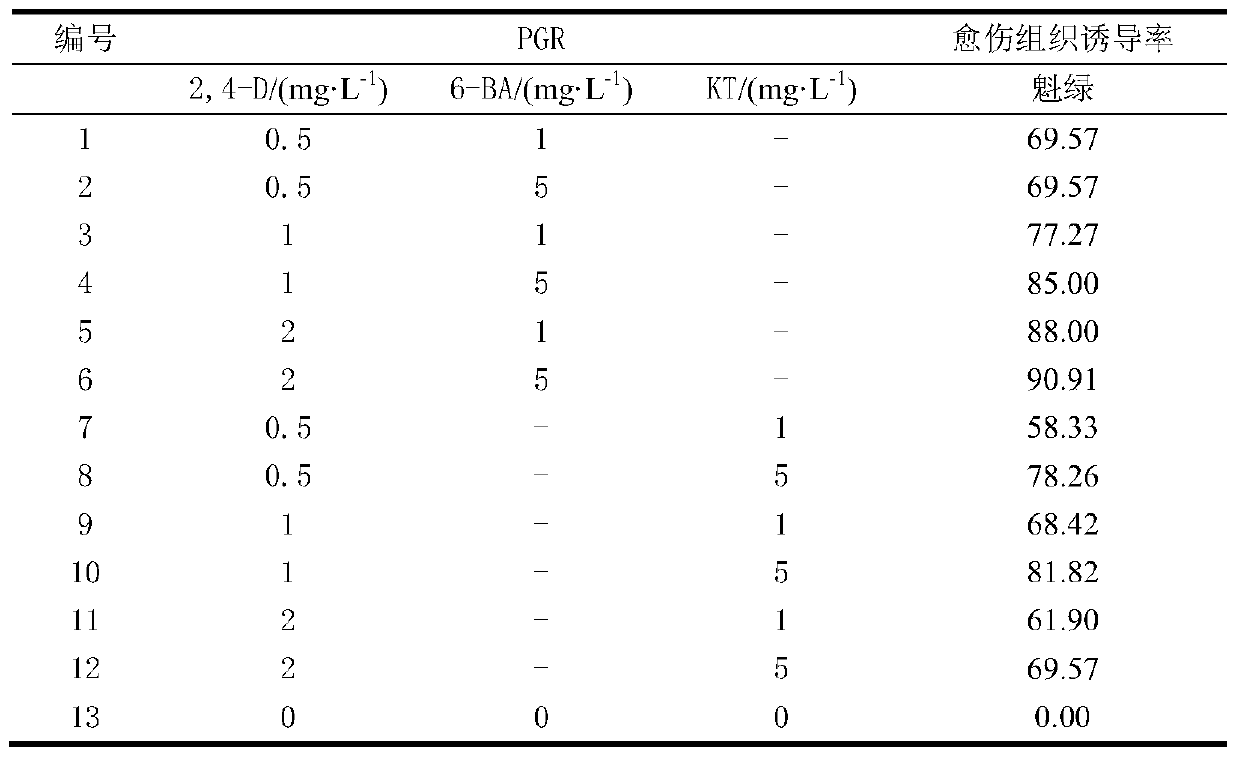A method for cultivating actinidia anthers into haploid plants
A technology of kiwi fruit and haploid, which is applied in the fields of botanical equipment and methods, horticultural methods, plant regeneration, etc., can solve the problems of long cycle and low efficiency of hybrid breeding, achieve simple operation, improve selection and breeding materials Effect
- Summary
- Abstract
- Description
- Claims
- Application Information
AI Technical Summary
Problems solved by technology
Method used
Image
Examples
Embodiment 1
[0033] 1) Experimental material: Select 'Kuilu' plants that grow robustly and are free from diseases and insect pests. From 9:00 to 11:00 in the morning on a sunny day, the immature flower buds of "Kuilu" were collected, and the microspore development period was observed by the acetic acid magenta staining method. use;
[0034] 2) Low temperature treatment: put the collected flower buds in an environment of 2°C for pretreatment for 1 day. After the pretreatment, flower buds in the mononuclear marginal stage are selected respectively, and after disinfection and sterilization, the anthers are stripped. Anthers were inoculated on callus induction medium. 5-7 anthers were inoculated in each bottle, 10 bottles were inoculated for each treatment, and repeated 3 times. Cultivate in the dark for 20 days at 23°C;
[0035] 3) Induction of plant regeneration: when the induced callus grows to a diameter of 3-5 mm, it is transferred to the plant differentiation medium of Actinidia jujub...
Embodiment 2
[0039] 1) Experimental material: Select 'Kuilu' plants that grow robustly and are free from diseases and insect pests. From 9:00 to 11:00 in the morning on a sunny day, the immature flower buds of "Kuilu" were collected, and the microspore development period was observed by the acetic acid magenta staining method. use;
[0040] 2) Low temperature treatment: put the collected flower buds in an environment of 4°C for pretreatment, Process 1d, 3d, 5d, 7d, 10d After the pretreatment, the flower buds in the mononuclear stage were selected, rinsed with tap water for 30 minutes, and under aseptic conditions, the flower buds were sterilized with 70wt% alcohol for 30 seconds, rinsed with sterile distilled water for 3 to 4 times, and washed with 0.09wt% HgCl 2 The solution was sterilized for 5 minutes, rinsed with sterile distilled water for 3 to 4 times, and the anthers were stripped off. The anthers were inoculated on callus induction medium (MS+2,4-D 0.5 mg / L+6-BA 1.0 mg / L+sucrose ...
Embodiment 3
[0049] 1) Experimental material: Select 'Kuilu' plants that grow robustly and are free from diseases and insect pests. From 9:00 to 11:00 in the morning on a sunny day, the immature flower buds of "Kuilu" were collected, and the development of microspores was observed by acetic acid magenta staining. Tetrad, single-core early, single-core to the side inflorescence apical bud , collecting the flower buds at the top of the inflorescence where the megaspore development is in the uninucleate marginal stage for several days, and set aside;
[0050] 2) Low-temperature treatment: put the collected flower buds in an environment of 2°C for pretreatment for 5 days. After the pretreatment, select the flower buds in the single-nucleus marginalization stage, wash them with tap water for 30 minutes, and wash the flower buds with 75wt% alcohol under aseptic conditions. Disinfect for 30s, rinse with sterile distilled water 3 to 4 times, and use 0.12wt% HgCl 2 The solution was sterilized f...
PUM
 Login to View More
Login to View More Abstract
Description
Claims
Application Information
 Login to View More
Login to View More - R&D
- Intellectual Property
- Life Sciences
- Materials
- Tech Scout
- Unparalleled Data Quality
- Higher Quality Content
- 60% Fewer Hallucinations
Browse by: Latest US Patents, China's latest patents, Technical Efficacy Thesaurus, Application Domain, Technology Topic, Popular Technical Reports.
© 2025 PatSnap. All rights reserved.Legal|Privacy policy|Modern Slavery Act Transparency Statement|Sitemap|About US| Contact US: help@patsnap.com



